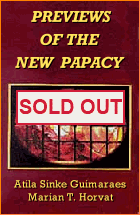Art & Architecture
 |
 |
 |
 |
 |
 |
 |
The Cathedral of Orvieto – II
What Is Behind the Rebirth of Gothic?
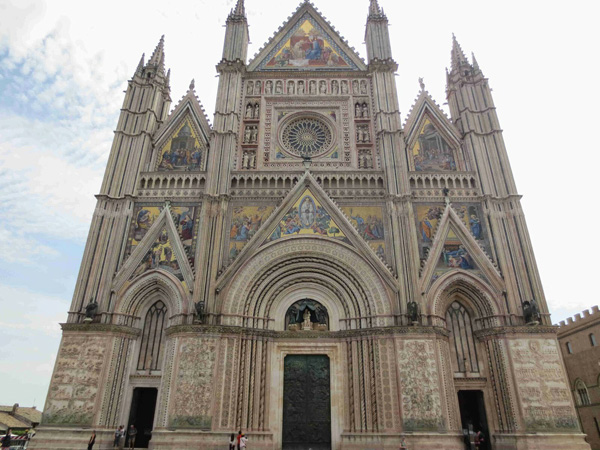
Over the three thresholds of the Cathedral of Orvieto, which we started to analyze in the last article, you may observe, the scenes of the Baptism of Our Lord, at left, Nativity of Our Lady, at right, and the Assumption of Our Lady, center. You see the intricate detailed stone work on the small columns, the rose stain glass window, the large square that surrounds it, the borders, the piecings, the floral decor at the top. The men who did this work were not rushing to finish or be applauded; they died in peace before an unfinished cathedral, certain that the future generations would complete it.
It seems to me that this church, like many others, can be censured in nothing regarding its beauty. I do not believe that anyone can have any reservations about that. One can prefer this or that church – it depends on the taste of each one – but I do not think it is possible to criticize this Cathedral for anything in its beauty.
This brings us to a side consideration that has importance in the field of the Revolution in the tendencies and in History. How was it possible for men to become so closed to the beauty of this gothic style that, for centuries, this genre of buildings stopped being constructed? The gothic was replaced in churches, monasteries, abbeys, public building and private residences with the classical Roman style with its banal semicircular arches and its plain, common straight lines in the porticos. The gothic stopped being chosen; it was rejected and set aside for centuries.
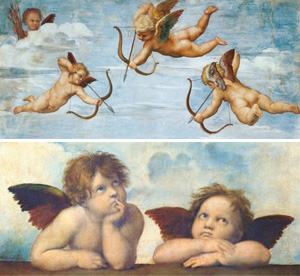
Above, angels by Raphael;
below, by Fra Angelico
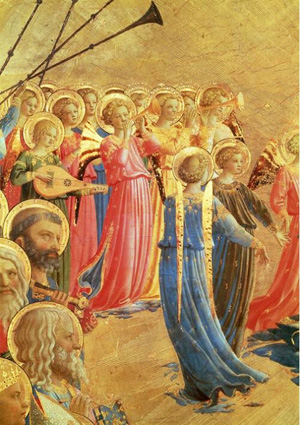
Also, when the film caught aspects of St. Peter’s Basilica – beautiful and imposing aspects – I thought: “Why not the gothic?” If St. Peter’s Basilica had been conceived in the style of Orvieto Cathedral, what an extraordinary monument it could have been!
So, what happened to those men with indisputable genius, the great artists of the Renaissance, that made them leave the gothic path? Why did they resolve to take off from the dust of ruins and restore an Antiquity that Christianity had shattered?
As you know, the gothic was buried in oblivion through the whole period of the Ancien Régime in France. Simultaneously, in other countries the baroque and rococo styles were adopted.
Let us imagine that in the Renaissance, a group of counter-revolutionaries in Orvieto would have decided, as a reaction against the classical style, to gather together all the people who admired their cathedral. They would convene often to discuss and praise that magnificent work of art, and disseminate their ideas with the aim of attracting others of similar mind.
After many years of this effort, some 50 enthused people would form the nucleus of the movement and around 1,000 would have a vague sympathy for it; people who would look at the Cathedral and say with a smiling, sleepy nostalgia: “It is so beauuutiful!” If this were the fruit of that hard work, we would say that the gothic had died in the history of human admiration.
Well, the French Revolution exploded, followed by the Directory, and then Napoleon; the Bourbons returned and History continued. About the same time as the restoration of the Bourbons – whether it is a coincidence or not, I don’t know – the taste for the gothic was reborn in almost all of Europe.
As you know, the State Council of King Louis XVI had decreed the razing of the Cathedral of Notre Dame in order to build a church in the Greek style, considered at the time to be the only style worthy for the Cathedral of Paris; the gothic was considered unworthy…
By one of those ironies of History, it was the French Revolution that saved Notre Dame. Those bandits, in their eagerness to always do the opposite of what the King wanted, kept Notre Dame Cathedral as it was. This is what saved Notre Dame from being razed to the ground.
After the crimes of the Robespierre, Danton and Marat, after the singing of the Ça ira, Carmagnole and Marseillaise by the people, after the roar of the cannons of Napoleon, which changed the old order in all of Europe, a different state of spirit emerged, one that was sympathetic to the gothic.
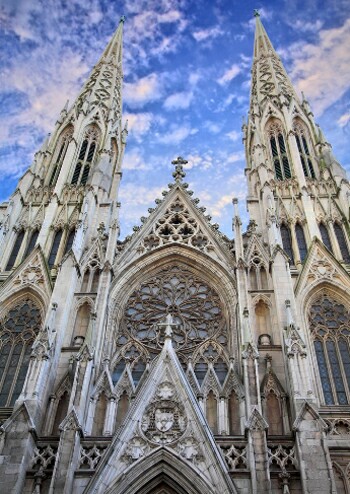
St. Patrick's Cathedral, New York City
You see that it was a state of spirit that was reborn from a single sweep of a new wind, a thing that groups of counter-revolutionaries could not have attained in decades of work. They would have fought with logic and good arguments, and this in itself would have been a beautiful thing. But, their fruit would be small because of the loss of horizons in the human mind that made the people insensible to the charm of the gothic.
Then, after the great traumas caused by the Revolution, in the human soul a keynote changed and people became enthused with the gothic once again. What factor caused this change, which the long fight of good people could not achieve?
I believe it was due to a grace.
It is common to attribute the rebirth of the gothic to Romanticism. In the 19th century, Romanticism was a philosophical school with moral and artistic branches that spread a sensibility and a taste for the arts. I believe that actually Romanticism was a deformation of an immense grace that, after the French Revolution, descended over Europe and the West, which was meant to return men to the good path.
This grace was half-accepted and half-deviated by Romanticism, which became a kind of caricature of this grace. A Saint who championed the good sides of Romanticism and combated its bad was St. Clemens Maria Hofbauer (1751-1829). Part of his apostolate unfolded in Vienna and South Germany. It would be necessary for us to study his life in order to see the good aspects of Romanticism and understand this grace.
We could include in this grace also the restoration of Thomism, which had been almost completely rejected and was restored by the Encyclical Aeterni Patris of Leo XIII.
These are some side commentaries on the Cathedral of Orvieto.
Now, let us close with another photo of this magnificent gothic structure.
Viewed from the side, you notice its beauty from another angle. The light of the frontal mosaics does no longer shine, but there is another form of beauty: It is not the brightness of gothic beauty, but a depiction of the nobility of its beauty, which is not proclaimed but insinuated.
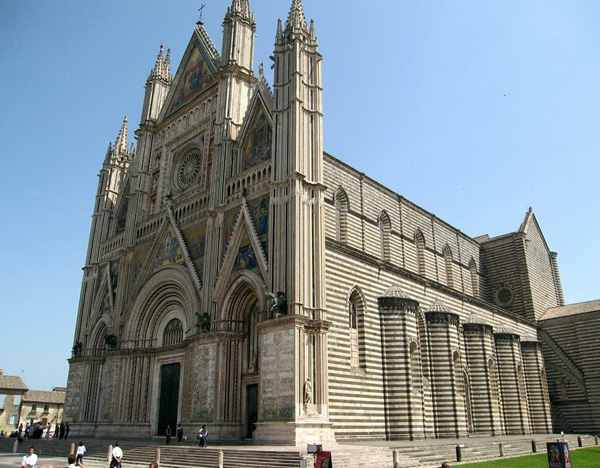
The side view expresses the distinction and nobility of the gothic beauty

Posted November 2, 2015
______________________
______________________











